ELK POINT - HEAVY OIL With the permission of The Roughneck August 1985
THE LINDBERGH HEAVY OIL DEVELOPMENT
Our apologies for photo quality. We are working off a photo copy.
Why Elk Point is turning into one of Alberta's fastest growing towns
You could say Elk Point is turning into the new Drayton Valley, an oil boomtown on the grow, but fortunately, in the 1980's the expansion of Elk Point will be far more civilized. Oil of course is where you find it. In this case it is heavy, it is profitable because of primary production, and it has been discovered in large quantities a few miles southeast of Elk Point in an area called Lindbergh. This part of northeast Alberta is presently the scene of heavy oil development that can only be described as intense. The concentration of people and equipment in one square mile is greater than that in any comparable area of farmland in the province. The attraction is not just the Clearwater, Sparky and Cummings zones that contain heavy oil and sonic gas, but the fact that at Lindbergh the driller is rewarded with primary production right after the well is completed. At present the vast majority of the 1000 or so wells in the Lindbergh field produce on primary production. This has significantly altered the pace of development of the Lindbergh field and makes it much different than deposits to the north like Wolf Lake and Cold Lake. Producing wells can average 4 cubic metres per day of 12 degree API gravity oil, and the occasional well will produce tine times that amount with a progressive cavity pump. This puts Lindbergh's daily oil production in the area of 4000 cubic metres per day, or over 24.000 BOPD.
The companies developing Lindbergh get some cash to work with while the thermal recovery projects are under construction. This simple combination. extensive reserves plus primary production to subsidize the development costs, is what has helped turn Lindbergh into what is probably the busiest oilfield in Alberta.
To facilitate orderly development and to avoid confusion on leases, the ERCB has classified the deposits at Lindbergh crude bitumen, or oilsands, even though the technical definition would call them extra-heavy oil because of primary production. The Bonnyville area is a transition area between oilsands to the north at Cold Lake. and extra-heavy oil to the south at l,loydminster.
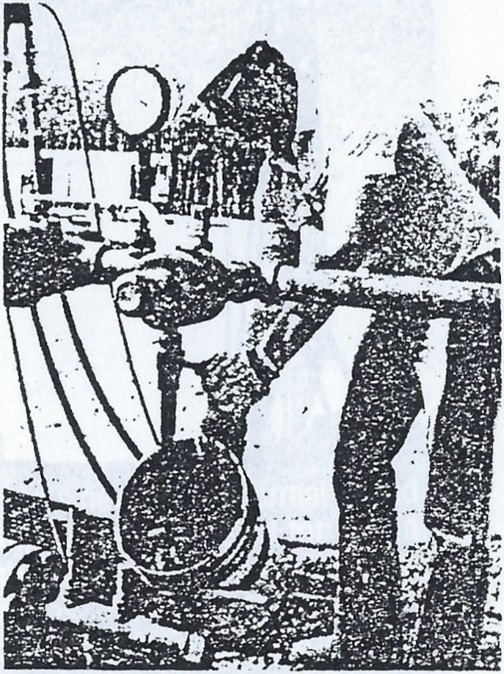
Bernie Goruk, Amoco's Elk Point project manager, demonstrating what 12 degree API gravity crude looks like on primary production
The Lindbergh deposits run in a northwest by southeast direction and are about 15 miles long and 10 miles wide. Step out drilling is proving the field has a larger area extent that earlier thought. The deposits were originally discovered by Westmin Resources in 1977 and HBOG, now Dome Petroleum, in 1978. Since that time four operators, Westmin, Dome, Pancanadian Petroleum and Amoco Canada Petroleum have acquired mineral rights and become the major players.
There were live drilling rigs working at Lindbergh in late July, one of which, Sierra Drilling, was drilling a slant pad for Dome. These rigs are adding at least 10 wells per week to the field. Workover and completion activity is also intense. On a given day Amoco alone has 6 service rigs employed, a figure that will rise to 12 by the end of the year. The four operators must have twenty or more service rigs working in the area every day. One of the major factors in the steady workover is that the produced oil carries a great deal of sand into the Wellbore, more so at first than later the life of the well.
Then there is the construction activity. Amoco has its main $8 million steam generating and cleaning facility under construction, Westmin will be starting construction of its steam generator in August. while the other operators already have more facilities planned. While it is difficult to estimate exactly how many people are employed by all four operators on a given day, there are at least 2(X) direct and service-related workers on the drilling and service rigs alone. This does not include surface plant construction personnel. well operators, or crude or LNG haulers, let alone those involved in portable steam generation, lease construction and cleanup, or even the supervisory staff. To fully appreciate the amount of activity at Lindbergh one really has to go there and witness it firsthand. If no total employment figures are available, it is probably because everybody is too darn busy to bother counting all the bodies.
Heavy oil has unique development problems because of the small well spacing units employed for optimum reservoir drainage. The largest spacing for primary production is 40 acres, 16 wells per square mile, and on thermal recovery this is reduced to 10 acres or less, 64 or more wells per square mile. By comparison the spacing for natural gas development is one well per square mile. The impact upon farmland can be devastating and at least fur one generation of residents, permanent.
When the oil companies started development there were problems encountered with the residents. While most of the initial conflicts have been resolved, largely a matter of both sides understanding each other, the trend is now towards pad drilling to minimize surface impact and consultation with the local residents to make them aware of upcoming plans, projects and developments. Both slant pad drilling and deviated vertical pad drilling have been employed to minimize the surface impact of development, different operators having their own preference.
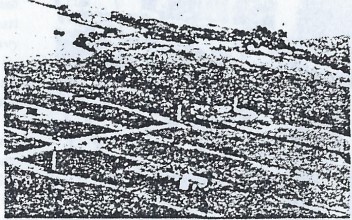
One square mile a Lindbergh with at least 16 active wells and three service rigs working simultaneously.
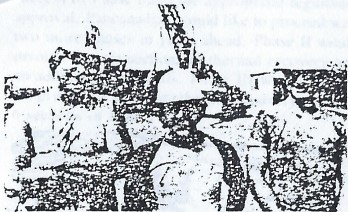
Westwood Well Servicing crew, left to right, Steve Jesson, toolpush, Alberta Bykowkwy, driller, and Lyle Fediuk, roughneck, in front of Westwood's slant rig on an Amoco pad
The town of Elk Point, the nearest community to all the action, may be the fastest growing town in Alberta, at least statistically. The population has grown by 14 percent in the last year, by .150 people to 1250. It would grow faster but the physical constraints of how quickly and efficiently accommodations can be constructed sets the pace. Many workers are housed in trailers outside of town or commute to Bonneville.
While only three new houses were built in 1984, a 50 lot subdivision is under construction and a 35 unit apartment block has been completed. An even larger apartment complex is being built. Add the two new hotels, a hardware store, and 10 new oilfield service and supply companies in the past two years, if the residents of the once quiet little town of Elk Point have wondered just what in blazes is going on, it should come as no surprise.
One innovation of the local oil patch unique to Elk Point is something called the RCMP Oil Patch Watch, the petroleum version of the Range Patrol. The problem was that oilfield thefts were becoming a major problem with all the activity, hence the newly formed Elk Point Oilmen’s Association got together with the RCMP and came up with Oil Patch Watch. The way it works is that if any oil company worker Wes a suspicious looking vehicle in the field. the license number is taken down and forwarded to the RCMP and a notice is placed under the windshield wiper. Be advised that if you plan to tour Lindbergh by car, you may avoid sonic hassles by first checking in with the RCMP.
A brief overview of each operator is:
WESTMIN RESOURCES LTD.
Westmin Resources was drilling for gas in the Lindbergh area in 1977 when it first discovered the heavy crude deposits. Today the company has a land position covering 34 sections, WO percent Westmin. and has had commercial oil production from the area since 1979. Westmin operated about 200 wells prior to 1985, plans to add 41 this year. and produces about 3300 BOPD from Lindbergh.
Of the wells to he drilled in 1985. one quarter section. 160 acres, will he drilled on 10 acre spacing for primary production. Another 12 well program will he drilled on 10 acre spacing and will go directly to steam drive recovery. The construction of the steam generating facility will begin in August and is expected to be completed by December.
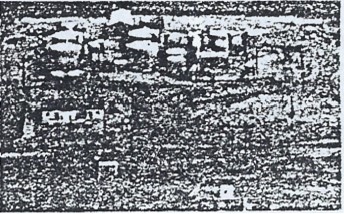
Westmin's main cleaning facility
Future plans include application to the ERCB for permission to drill 1 1/2 sections, 13 and 15. 55-6W5, on 10 acre spacing for primary production. Westmin has a staff of 53 at Lindbergh and averages lout service rigs under contract every day
PANCANADIAN PETROLEUM LTD.
Pancanadian Petroleums Ltd. drilled 32 wells at Lindbergh in 1983, 24 wells last year. but this year plans 200 development wells in what it calls Phase 1 of a proposed three phase development. This year's activities will take place on 16 sections of land, 2 of which will be dedicated to experimental thermal recovery. Also planned for Phase 1 are heavy oil cleaning plant, the installation of one steam generator, plus routine production facilities, the electrical network. and produced vapor recovery.
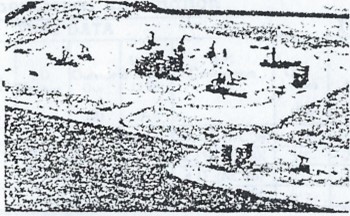
A Pancanadian pad with three service rigs working.
Depending upon world oil prices, economics, the Success of Phase I and the appropriate regulatory approval. Pancanadian would like to proceed with two more phases in years ahead. Phase II would involve 3 more sections of thermal recovery and an additional 50 wells. Phase III would include the drilling 300 more thermal recovery wells on 4 sections of land.
DOME PETROLEUM LTD.
Dome has been active at Lindbergh for five years through a farm-in on 101.5 sections of and with Sulpetro and CNG. Dome has already drilled 470 wells. 119 of which were classified as FOR and 265 as delineation wells. The bulk of the FOR activity takes place on sections 18-55-5W4 and 24-55-6w4. both of which are drilled on 10 acre spacing.
Dome plans to obtain commercial FOR production live more sections, one of which. 10-56 6W4. is presently being slant drilled. Over the next five years’ time plans to raise its daily production at Lindbergh to 15,000 BOPD. This will a further 150 primary production wells outside of the Lindbergh FOR units. Dome's planned capital investment will he $158 million in 1985 dollars. and when operating costs are included.
Dome will he spending some $400 million at Lindbergh over the life of the project.
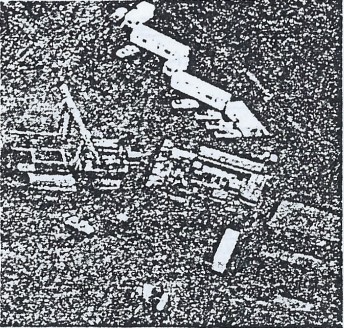
Sierra Drilling's slant rig drilling a pad for Dome
AMOCO CANADA PETROLEUM LTD.
Amoco drilled its first Lindbergh will in December, 1981 and since has drilled 100 wells and is presently producing 1500 BOPD. Of these 100 cells, 82 are vertical primary producers while the others are slant wells from pads that can he expanded to contain 32 or more wells. An additional 70 wells will be added in 1985. By July, 1986, Amoco will have a total of 258 cells and hopes to operate production of over 20(8) BOPD.
During the experimental first stage. Phase Amoco will he spending an average of $21 million annually at Lindbergh. a figure expected to increase sharply should the company move to commercial development. Amoco is experimenting with both huff and puff and steam drive. A 13 well steam drive recovery project is being drilled vertically on 2.5 acre well spacing south of the steam generating facility being constructed on 28-55-6W4.

Typical lease with one well being worked over while the other is on production
Should the company proceed to Phase II, plans include 5 acre thermal recovery projects, 128 wells per section, and enlarging of the existing cleaning facility !min -10(X) hid to 26,(XX) hid. By 1995, when Phase III would continence, production would be 23.000 hid. The purpose of Phase III, if implemented, would be to maintain the project until it projected termination, 2010 or 25 years from now.
Amoco presently has three drilling rigs and six service rigs employed at Lindbergh.
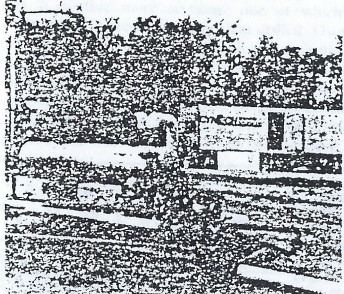
Portable steam generator with unit to increase team quality in foreground on an Amoco location



